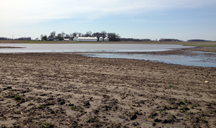Purdue agronomist: Don't fall for the three tillage temptations
April 25, 2013
 |
|
Heavy rainfall has kept
Indiana and Ohio corn growers from tilling fields and planting crops. Even with
the delays, a Purdue Extension agronomist urge farmers not to get too hasty
with tillage operations. (Purdue Agronomy photo/Tony Vyn)
|
WEST LAFAYETTE, Ind. - A Purdue Extension agronomist is urging corn farmers not to let planting anxiety drive them to fall for three common tillage temptations: too early, too wet, and too often.
Heavy rainfall and cool temperatures have delayed planting and tillage operations in Indiana and Ohio. As of April 22, less than 1 percent of the corn crop had been planted in both states, and there had been only a few days suitable for fieldwork.
Farmers often become too eager during weather delays, which can lead to risky or unnecessary field operations, Tony Vyn said.
"A couple of weeks ago, we had a lot of growers out doing tillage well before they intended to plant," he said. "The only time it's appropriate to till early is if you plan to plant into a stale seedbed once the weather allows for planting."
Instead, Vyn said corn growers should plan to postpone spring tillage until that field is within 24 hours of the intended planting time - especially in fine soils where the risk of erosion, gullies and soil crusting is highest.
Reasonably level fields with sandy and loam soils often are the best candidates for planting into a stale seedbed because soil crusting with intense rain is less likely. However, all soils are most susceptible to erosion losses when intense rain comes right after tillage and before drying cycles have had the opportunity to help restore soil aggregate stability.
Beyond proper timing of tillage operations, Vyn said producers should avoid working ground when it's too wet.
"We're having a wet spring, we're expecting more rain, and farmers have a lot of acreage to plant, so the temptation is there to till when it's too wet," he said. "The problem is that tilling wet soils can cause compaction. You can lose a lot more yield with compaction than with delayed planting.
"Just because the tractor doesn't get stuck doesn't mean you should be out there."
Even if the soil surface is dry, Vyn said corn growers need to do more to determine if fields are ready for tillage.
First, growers need to be sure the soil will break apart at 1 inch below the depth of tillage. Producers can easily determine if soil is ready by taking clumped soil from the depth of tillage and rolling it between their hands. If the soil forms a "worm" that is 5 inches long with a diameter of three-eighths of an inch or less, it's too wet.
The final tillage temptation Vyn said growers should avoid is tilling too frequently. Fields with soybean stubble and those with sandy and loam soils are candidates for no-till corn. And in some situations where full-width tillage is tempting, a single pass of strip-tillage is enough.
"Where we go with tillage has a lot to do with long-term soil health," Vyn said. "We are facing huge weather changes from 2012 to 2013, so it's extremely critical that we think of using tillage or no-till to improve soil resiliency for whatever weather we're expecting.
"There is a lot of emphasis on choosing the right hybrids, but with tillage it's important to understand the potential corn yield loss and season-long, root-zone soil damage done by tilling too early, too often and when soils are too wet."
Writer: Jennifer Stewart, 765-494-6682, jsstewar@purdue.edu
Source: Tony Vyn, 765-496-3757, tvyn@purdue.edu
Ag Communications: (765) 494-2722;
Keith Robinson, robins89@purdue.edu
Agriculture News Page

